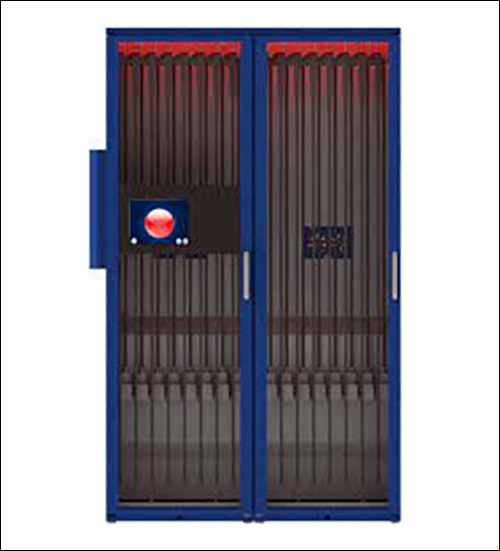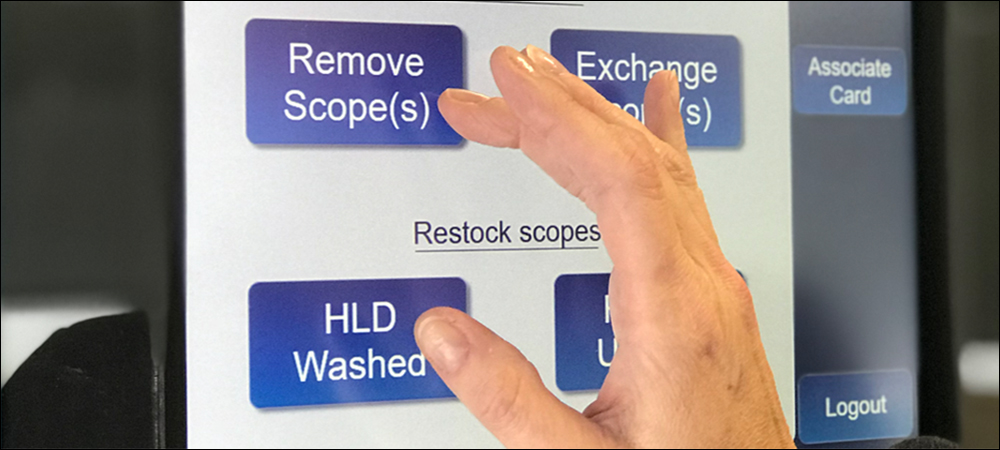- Highly Regulated Cleaning Process
- Reduced Handling of Endoscopes
- Tracking Endoscopes in Drying Cabinets
Aug 29, 2022Pittsburgh-based healthcare logistics company Mobile Aspects is selling an endoscope storage cabinet with a method for drying, including in the device's channel, while tracking data regarding the items inside the cabinet, via RFID technology. The company says the system, known as iRIScope, is the only such solution that offers automated channel drying along with RFID to capture real-time data about the process. Mobile Aspects has patented the solution.
The iRIScope includes an endoscopic cabinet with a built-in 13.56 MHz HF RFID reader compliant with the ISO 15693 standard, as well as air- and channel-drying functionality, in addition to back-end software that manages the collected data. Already, Mobile Aspects has been offering an RFID-based solution for monitoring the washing, drying and use of endoscopes. The cabinet adds to that system by offering automated channel drying, along with RFID data capture.
Endoscopes are inspection instruments that are inserted into patients' orifices during tests and procedures. They are reused many times, sometimes as often as 200 times per year, and the use of such devices has been growing. Early detection procedures like colonoscopies and camera-based diagnostics are becoming more commonplace, while the hollow, flexible tube scopes are increasingly being utilized for minimally invasive surgical procedures that previously were carried out with a scalpel.
Most such scopes are highly expensive pieces of equipment with built-in electronics, including cameras. As such, the cleaning process must be performed properly to ensure the equipment's integrity, while eliminating any pathogens before the assets are used on other patients. "The cleaning process of endoscopes between patients' procedures is extremely important and complex," says Suneil Mandava, Mobile Aspects' founder and CEO.
Highly Regulated Cleaning Process

The iRIScope cabinet
Because of the high sensitivity of the built-in equipment, the endoscopes cannot sustain the type of cleaning and sanitizing performed by forceps and other surgical tools. Instead, they must undergo a process known as high-level disinfection (HLD). The cleaning of scopes is quite challenging, and hospitals employ individuals with specific experience to ensure the process is carried out properly. It can take up to 100 steps to clean a single scope in between usage. The cleaning process must be carried out within an hour or so after a procedure is completed, and it takes place in a disinfecting machine known as an automated endoscope reprocessor.
The Joint Commission (TJC) has been passing requirements regarding medical equipment sterilization (IC.02.02.01). TJC found that in 2016, 74 percent of all immediate threats to life were related to improperly sterilized HLD equipment. Breaches in proper sterilization processes can lead to outbreaks of HIV, hepatitis B and C, and such infectious agents such as E. coli and salmonella, the commission reported. Therefore, TJC has been mandating that hospitals have documentation indicating they have cleaned their scopes properly.
Infections can occur even during the handling of the equipment between patients, Mandava says. Bacteria or microbes can linger on an endoscope as staff members sort through them to select specific scopes for use. "There's a lot of touching of each individual scope through the process," he explains, "making it easier to pass bacteria to a patient." The IRIScope, Mobile Aspects claims, is the only solution on the market that uses RFID to automatically track and document each endoscope's full round trip from storage to patient, then to cleaning and back to storage.
According to Mandava, a tag is attached to the scope's "non-business end," where the device is plugged into a machine to connect the light that passes through the scope. (The business end is inserted into the body.) "We've specially designed [the tag] with medical-grade materials," Mandava says, to sustain the cleaning processes the scopes will endure. Each tag is encoded with a unique ID number that is linked in the software to a particular piece of equipment, and as the tag is read at multiple points during the device's usage, data is updated and can be linked to the patient's medical records.
Reduced Handling of Endoscopes
When clinicians read tags before and after cleaning, the RFID-based data enables healthcare companies to track when each procedure took place, when the cleaning was completed, by whom and when the devices were moved into storage. Traditionally, while documenting the processes completed for each scope, hospital personnel write on clipboards or scan barcodes, and both processes require an extra touch of the endoscope.
This is a slow task, the company notes, which can be prone to errors. While the iRIScope makes that process more automatic, healthcare companies have recently been seeking a way to accomplish and document the drying process, including the scope's channel—the hollow center of the tube. Mobile Aspects thus designed a cabinet that can store up to nine scopes at a time, which blows air around the devices, as well as directly through the channels.
This process forces liquid off the endoscopes, pushing it down, while the mechanics of the cabinet recirculate every 10 minutes. The cabinet comes with a built-in RFID reader supplied by a third-party provider, which Mobile Aspects has declined to name due to intellectual property constraints. It also features an array of antennas designed by Mobile Aspects.

Back-end software manages the collected data.
Tracking Endoscopes in Drying Cabinets
To use the cabinet, employees first leverage a touchscreen to select from a list of patients who have procedures pending. They select a specific patient and typically scan a barcode to link them with the patient and the endoscope needed, after which they can access the cabinet and select the scope they require. The system, which no longer reads that tag ID, updates the software indicating that scope is now being used, as well as by whom.
The hospital can view, in real time, which scopes are in each cabinet, enabling it to identify where workers can go to access the scopes they need. If the scopes are not used after seven days in the drying cabinet, they must be recleaned. The software can provide alerts indicating which scopes require recleaning, and in which cabinets. Mobile Aspects also provides an RFID-based solution to track implantable devices, such as transaortic or cardiac valves, or hip or knee joints, to help healthcare providers locate the right implant prior to surgery, as well as create a record of which device was implanted in a given patient, and when this occurred.
Mobile Aspects provides the custom-designed HF RFID tags. The company opted to use an HF tag as an alternative to longer-range UHF tags, Mandava says, because the lower-frequency versions offer a short range and reliable reads around liquids and metal. The company makes the tags color-coded to help users visually distinguish between different scope types. For instance, orange tags may be attached to scopes intended for the GI tract, while blue tags could indicate a pediatric-size scope.
The cabinets are already in use at several hospitals, ensuring the safe drying of endoscopes and their channels, while capturing data about the process automatically. Mobile Aspects tags products for its customers, then trains hospital personnel to tag new assets as they are received, or as tags need to be replaced. The company says the solution has reduced the number of touches to which endoscopes are exposed, since RFID can scan and document data touch-free. That, Mandava says, eliminates the need for workers to pick up devices to write down serial numbers, identify what type they are, or place stickers on them indicating they have been cleaned.
Key Takeaways:
- The RFID-based cabinet ensures healthcare workers can quickly access the correct cleaned and dried endoscope for a particular patient procedure.
- The system is intended to capture data automatically for a hospital and regulators, while reducing the number of times the scopes are handled before being used on patients.

